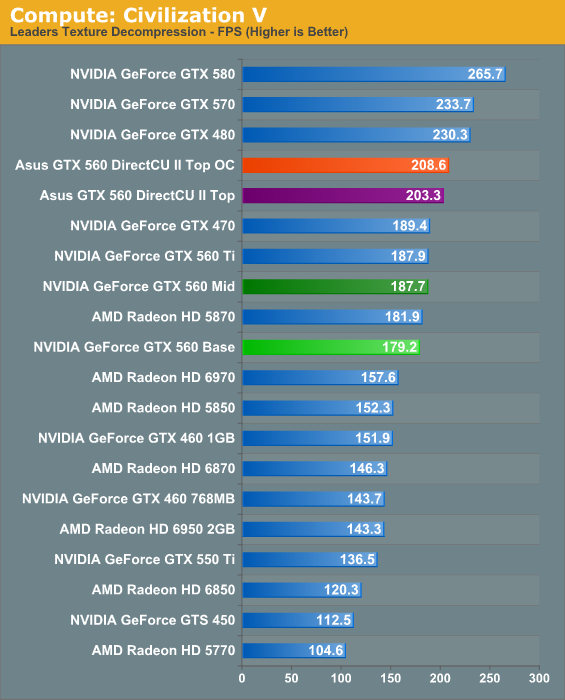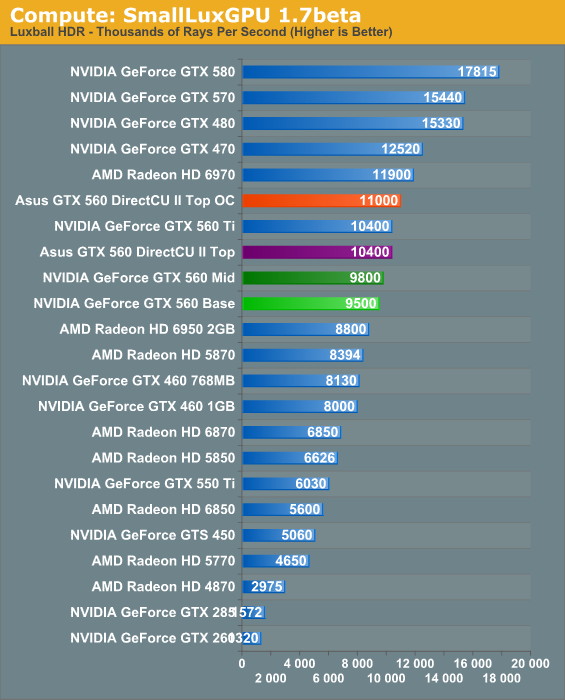NVIDIA's GeForce GTX 560: The Top To Bottom Factory Overclock
by Ryan Smith on May 17, 2011 9:00 AM ESTCompute Performance
Moving on from our look at gaming performance, we have our customary look at compute performance. Since compute performance is by definition shader bound, the GTX 560 is at a bit of a disadvantage here. Whereas the higher clocked ROPs would offset some of the GTX 560 Ti’s gaming lead, here the GTX 560 has nothing to stand on besides raw shader power.
Our first compute benchmark comes from Civilization V, which uses DirectCompute to decompress textures on the fly. Civ V includes a sub-benchmark that exclusively tests the speed of their texture decompression algorithm by repeatedly decompressing the textures required for one of the game’s leader scenes. Note that this is a DX11 DirectCompute benchmark.

This benchmark threw us for a bit of a loop, and we ended up running it several more times just to be sure. Under most circumstances the texture decompression test should be shader bound, but here it’s not – or at least not entirely. The GTX 560 Mid and GTX 560 Ti basically tie here, which is quite odd since the GTX 560 Ti has quite a shader advantage due to the 8th SM. As best as we can tell, either texture decompression doesn’t scale well with SMs, or it’s memory bandwidth bound at some point, with the latter case being the more likely of the two.
In any case as a result the GTX 560 Mid does quite well here, and the ASUS GTX 560 with its factory overclock shoots right past everything short of the 480/570/580. We’ll have to see if this weird outcome holds up in our other compute benchmark.
Our second compute benchmark of the day is SmallLuxGPU, the GPU ray tracing branch of the open source LuxRender renderer. While it’s still in beta, SmallLuxGPU recently hit a milestone by implementing a complete ray tracing engine in OpenCL, allowing them to fully offload the process to the GPU. It’s this ray tracing engine we’re testing.

Under SmallLuxGPU the GTX 560 behaves much more like we’d expect it to. The GTX 560 Mid does well, but it still falls behind the GTX 560 Ti as we’d expect. Keeping in mind that the theoretical difference should be around 10% in favor of the GTX 560 Ti however, the GTX 560 Mid still does a bit better than we were expecting, letting the GTX 560 take off with only a 6% lead. Compared to the GTX 460 however the difference is almost exactly what we’d expect it to be: the GTX 560 Mid is ahead by 23%.
Overall our compute results leave us a bit surprised: while extra shaders are normally extremely beneficial on compute benchmarks, that’s not entirely the case here. The GTX 560 series was never meant to be a compute powerhouse like the GTX 570/580, but if compute performance is a factor in your purchasing decision then it looks like you aren’t giving up much moving from a GTX 560 Ti to a GTX 560 Mid.










66 Comments
View All Comments
Ryan Smith - Tuesday, May 17, 2011 - link
In this case we only had the single card.buildingblock - Tuesday, May 17, 2011 - link
My local hardware dealer has the new 560 (non-Ti) in stock today. True, only two models so far but the cheapest 560 in stock costs less than the cheapest 6870 in stock, and even less than some of the 6850s. And that's the issue, graphics cards are about price points. Its no good going on about the AMD 6950 to buyers who are only looking at choosing either a 560 or a 6870, because both are around the same price point. And as already said, the 560 today is actually at a better price point at this dealer than any 6870.One reason why the majority of discrete desktop graphics card buyers continue to purchase nVidia is the quality of the drivers. Or the continuing issues with AMD drivers. There is an example here http://forum.team-mediaportal.com/746244-post1.htm... of a guy who's having problems rendering a web page with a 6950. Yes, that's right a web page, now don't going playing games with it will you.... What he is seeing is partly because the page has a Shockwave slideshow. He complains that GPU usage constantly fluctuates between 0-8-18-44%, with a 6950. With a GTX 550 Ti GPU usage figures 0-2-11% - that's right only 11% with a GTX 550 Ti compared to 44% with an AMD 6950.
That's AMD drivers for you.
DanNeely - Tuesday, May 17, 2011 - link
Meh. That's not a real issue, as can be seen by the replies. Following up on it I'd speculate that the only reason the single time sample spikes at high load are spotted at 175mhz but not at 450 is that at the latter the render takes significantly less than the sample time so they get largely smoothed into the average (as can be seen by the smaller load spikes).There is one real issue in their drivers that's been annoying me significantly since I got my 5870 last summer. When running 2 monitors and a GPU app, when the app completes a work unit it drops down to single monitor speed for a second or three and ghost images from the top of one monitor flicker on the 2nd until the new task starts and the clocks throttle back up. I've made it go away by creating a profile and manually editing its config file so that the single monitor settings (which it enters despite 2 attached monitors) are no lower than the others. This makes the problem go away, but really...
ratbert1 - Tuesday, May 17, 2011 - link
I suggest reading more than one review before deciding which card is better. I do not get the same results as Anandtech does on the same benchmarks. I have a different platform and get different results. Their bench is useful for getting a rough idea, but there are a lot of other sites to check. Not all show the same AMD scores gotten here.I have tried to use AMD cards in the past. I really have, but with a 5850 I could not get it to work with a DVI connection, and with a 3450 it would bluescreen whenever I played a DVD. Both were sent back. All the other cards I have had (Nvidia) just worked!
I even recently looked at getting a 6950, but too many comments on Newegg were about the lousy drivers(too many for me anyway). I just couldn't do it.
L. - Wednesday, May 18, 2011 - link
Well, there's a fair chance your local hardware dealer sucks, as do all local hardware dealers.Get on the web man, its 2011.
At least you'll get to choose your brand and model for realz ;)
jiffylube1024 - Tuesday, May 17, 2011 - link
The GTX 460, ATI 6850 and 6870 are all still quite solid cards, and these charts prove it. Anyone with a GTX 460 (1GB) that overclocked it to 800-850 MHz basically has a GTX 560.It's nice to see the GTX 560 pushing the GTX 560 series at/under $200.
-----
I'm impressed with how much the 6870 has improved versus the 5870. When the 6870 came out, it was basically trumped by the 5870 in everything; now, if anything, the 6870 comes out a bit faster.
marc1000 - Tuesday, May 17, 2011 - link
you meant "The GTX 460, ATI 5850 and 5870 are all still quite solid cards"?because 6850 and 6870 are current-gen....
marc1000 - Tuesday, May 17, 2011 - link
Now I can not say to a friend "buy the GTX 560" when he asks if this card if better or equal to R6950. because he will probably buy the cheapest one, wich will have the SAME name, but is slower.ATI/AMD naming is bad, but Nvidia is worse!
LOL_Wut_Axel - Tuesday, May 17, 2011 - link
I don't know where you guys are getting this information, but the Radeon HD 6870 IS NOT at $180. Therefore, you shouldn't let that sway your opinion about this card. The Radeon HD 6870 is a $200 card, as is the GTX 560. Folders and gamers should go for the GTX 560, while people that want higher efficiency and same performance should go for the Radeon HD 6870.That alone leaves me with a very bad taste about this article. I suggest you read the review by Tom's Hardware and TechPowerUp instead.
starfalcon - Tuesday, May 17, 2011 - link
A 6870 can hit $170 on Newegg with a rebate, but $192 or so does seem to be the lowest without any rebates.